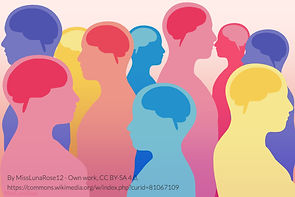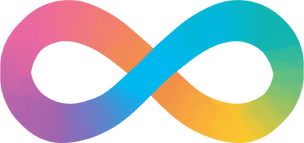Understanding Neurodiversity and Strengths-based Approaches to ADHD
Neurodiversity is the concept that neurological differences, such as ADHD, are natural and should be recognized and respected as any other human variation. It encompasses a range of conditions including ADHD, autism, and dyslexia. Embracing neurodiversity is crucial for creating an inclusive environment that celebrates the unique strengths and perspectives of individuals with ADHD.
-
Applying the Strengths-based Model of Neurodiversity to ADHD
-
Resources on neurodiversity

About Neurodiversity
The term neurodiversity, or neurological diversity, has been attributed to the Australian sociologist Judy Singer, who is autistic and advocated for the conceptualization of neurological diversity as natural occurrence in the human species. This term is analogous to how biodiversity refers to the diversity of biological species, or life, on earth. Neurological differences exist because of certain evolutionary advantages that they confer. Individuals who have brain differences that are present in the minority of humans, such as ADHD, autism, and learning disabilities, are considered neurodivergent, whereas those whose do not are considered neurotypical.
Advocates of the neurodiversity movement often ascribe to the social model of disability, which views disabilities as fluid constructs that depend on the specific social context. For example, in a society that values curiosity and high energy, ADHD may be considered an asset rather than a disability. On the other hand, the medical model of disability focuses on the deficits or pathology of conditions that are considered abnormal and need to be corrected by medical treatment. Transitioning from the medical model to social model of disability, it is important to acknowledge that neurodivergent individuals have both strengths and challenges. Cultivating strengths and providing support to challenges can help them to thrive and maximize their potential.
"diversity among brains is just as wonderfully enriching as biodiversity and the diversity among cultures and races."
- Neurodiversity : discovering the extraordinary gifts of autism, ADHD, dyslexia, and other brain differences,
Armstrong, T. (2010)

Neurodiversity Symbol
By MissLunaRose12 - Own work, CC BY-SA 4.0, https://commons.wikimedia.org/w/index.php?curid=80284071
Strengths-based model of neurodiversity
The strengths-based model of neurodiversity is an approach that recognizes and values the differences in how people’s brains function, focusing on the strengths and unique abilities of neurodivergent individuals rather than viewing their conditions as deficits or disorders that need to be "fixed." It is often used in education, workplace environments, and clinical settings to promote a more inclusive, accepting, and empowering perspective on neurological differences.
Key features of the strengths-based model of neurodiversity include:
Focus on Abilities and Strengths
Instead of concentrating on the challenges associated with conditions such as autism, ADHD, dyslexia, and others, this model highlights the talents and capabilities of neurodivergent individuals.
For example, individuals with autism may excel in pattern recognition, attention to detail, or long-term memory, while those with ADHD may thrive in fast-paced environments due to their energy and creativity.
Individualized Approaches
Each person’s neurodiversity is unique, and the strengths-based model advocates for personalized support and environments that play to the individual's strengths, helping them succeed in ways that are meaningful to them.
Embracing Diversity as Normal
Neurodiversity is seen as a natural variation in the human genome, much like differences in race, gender, or sexual orientation. This view fosters inclusivity, suggesting that society should adjust to accommodate diverse neurological profiles rather than expecting neurodivergent individuals to conform to neurotypical standards.
Positive Identity and Self-Esteem
By focusing on strengths, this model helps neurodivergent individuals develop a positive self-image. Instead of feeling "less than" or abnormal, they are encouraged to take pride in their unique qualities and contributions. This promotes psychological well-being and reduces stigma around neurodivergence.
Strengths in Real-Life Contexts
The model emphasizes how neurodivergent individuals can leverage their strengths in various domains, such as work, education, and relationships.
For instance, individuals with dyslexia may excel in spatial reasoning or entrepreneurial roles where innovation and risk-taking are rewarded.
Collaboration and Empowerment
The strengths-based model encourages collaboration between neurodivergent individuals and their support systems, whether that be educators, employers, or clinicians, to create environments that allow them to thrive.
The goal is empowerment, ensuring that neurodivergent individuals have the tools and accommodations necessary to succeed based on their strengths.


Applying the Strengths-based Model of Neurodiversity to ADHD
The strengths-based model of neurodiversity, when applied to ADHD, shifts the focus from deficits typically associated with ADHD (such as inattention, impulsivity, and hyperactivity) to the unique strengths and positive attributes that individuals with ADHD can exhibit. This approach emphasizes leveraging those strengths in educational, professional, and personal settings to enhance success and well-being.
Identifying Unique Strengths of Individuals with ADHD
People with ADHD often display certain strengths, including:
-
Creativity and Innovation: Individuals with ADHD frequently demonstrate creative problem-solving abilities and innovative thinking. Their brains often work in non-linear ways, enabling them to come up with original ideas or solutions that others may not think of.
-
Hyperfocus: While individuals with ADHD struggle with sustained attention on tasks that are not stimulating, they can enter states of intense focus (hyperfocus) on activities that interest them. This allows for deep engagement and productivity in those areas.
-
High Energy and Enthusiasm: People with ADHD often have abundant energy, which can translate into enthusiasm and drive in fast-paced environments or activities they enjoy.
-
Risk-Taking and Resilience: Individuals with ADHD tend to be more comfortable with risk-taking, which can lead to entrepreneurial success or excelling in challenging, dynamic environments.
-
Improvisation and Adaptability: ADHD individuals can adapt quickly to new situations and environments, often showing great improvisation skills when faced with unexpected challenges.

Creating ADHD-Friendly Environments
The strengths-based model encourages designing environments that allow individuals with ADHD to thrive:
-
Flexible Work/Study Spaces: Allowing for movement and variation in seating arrangements or providing options for standing desks can help ADHD individuals stay engaged.
-
Task Variation and Stimulation: Incorporating varied tasks, quick feedback, and stimulating activities into routines can help maintain focus and motivation. Breaking large tasks into smaller, manageable chunks can also increase productivity.
-
Support for Hyperfocus Periods: Instead of disrupting periods of hyperfocus, environments can support these periods by allowing longer work sessions or task autonomy during peak engagement times.

Leveraging ADHD Strengths in Education
-
Project-Based Learning: This teaching strategy plays to the strengths of students with ADHD by offering hands-on, dynamic, and creative projects that keep them engaged and motivated. It allows them to explore their interests and apply their learning in practical, real-world contexts.
-
Creative Assignments: Teachers can incorporate more creative and flexible assignments that allow students to use their imagination, storytelling, or artistic abilities, thus playing to their natural strengths.
-
Student-Led Initiatives: Giving ADHD students more autonomy in choosing their learning projects or methods can help them feel more empowered and invested in their success.

Workplace Applications
-
Dynamic Work Assignments: Employees with ADHD can thrive in environments where they are given dynamic roles, multiple projects, or fast-paced tasks that hold their attention. Task variety helps keep them engaged and productive.
-
Flexible Schedules: Offering flexible work hours, where employees can work during their most productive times (often during periods of hyperfocus), can maximize their efficiency.
-
Entrepreneurship and Innovation: Individuals with ADHD often excel in entrepreneurial roles because of their creativity, willingness to take risks, and ability to thrive in less structured environments. They can also excel in industries that reward innovation and quick adaptability.

Positive Reinforcement and Strengths-Based Feedback
-
Focus on Positive Feedback: Instead of emphasizing the challenges that come with ADHD, this model encourages giving feedback that highlights what the individual has done well. For example, acknowledging creativity, perseverance, or problem-solving abilities reinforces self-confidence.
-
Collaborative Goal-Setting: When setting personal, academic, or professional goals, collaboration between individuals with ADHD and their educators, employers, or coaches is key. This empowers individuals to capitalize on their strengths and achieve objectives that align with their natural abilities.

Emphasizing Self-Acceptance and Positive Identity
-
Developing a Positive ADHD Identity: The strengths-based model encourages individuals with ADHD to view their condition as a part of their identity, which includes both strengths and challenges. This helps build self-esteem, self-acceptance, and resilience.
-
Role Models and Mentorship: Identifying successful role models with ADHD who have leveraged their strengths can inspire individuals with ADHD to embrace their own potential and capabilities.

Example of Application
An entrepreneur with ADHD might struggle with administrative tasks like bookkeeping but excel in creative and strategic thinking. A strengths-based approach would involve delegating or automating the administrative work while focusing on leveraging the entrepreneur’s creativity and big-picture thinking to drive business growth and innovation.
Tools for Implementation
-
Strengths-Based Coaching: ADHD coaches or therapists can work with individuals to help them identify their unique strengths and develop personalized strategies for overcoming challenges while maximizing their natural abilities.
-
Educational Interventions: Schools and learning centers that apply the strengths-based model may develop individualized educational plans for students with ADHD, which focus on enhancing strengths while providing accommodations for areas of difficulty.
The strengths-based model of neurodiversity transforms how we view and support individuals with ADHD by emphasizing their unique talents and positive attributes. Whether in the classroom, workplace, or personal development, this approach fosters a more inclusive and empowering environment where individuals with ADHD can leverage their strengths to reach their full potential.

References
-
Armstrong, T. (2010). Neurodiversity : discovering the extraordinary gifts of autism, ADHD, dyslexia, and other brain differences (1st Da Capo Press ed.). Da Capo Lifelong.
-
Doyle, N., & McDowall, A. (2023). Neurodiversity Coaching : A Psychological Approach to Supporting Neurodivergent Talent and Career Potential. (1st ed.). Taylor & Francis Group.
-
Fung, L. K. (Ed.). (2021). Neurodiversity : from phenomenology to neurobiology and enhancing technologies (First edition.). American Psychiatric Association Publishing.
Other Resources
-
The Stanford Neurodiversity Project: initiatives with these objectives "Establish a culture that treasures the strengths of neurodiverse individual, Empower neurodiverse individuals to build their identity and enhance their long-term skills of daily living throughout the lifespan, Attract talented neurodiverse individuals to study and work at Stanford, Train talented individuals to work with the neurodiverse population. Disseminate the Stanford Neurodiversity Model locally, nationally, and internationally. Maximize the potential of neurodiversity"
-
Neurodiversity Network: "a website of resources for neurodivergent job seekers and students, employers & universities, & the community. Our mission is to consolidate various neurodiversity resources into one place. The goal is to share resources that help enhance neurodiversity awareness and acceptance for neurodivergents to find meaningful employment and positive educational experiences"
-
Neurodiversity Education Academy: "an educational, training and coaching platform focused on awareness, advocacy and capacity building for schools, parents and organizations"
-
Neurodiversity Foundation: "An organization focused on creating research, prototypes, co-creation schemes, to push forward the technical innovation that drives the move towards a more equal, inclusive neurodiverse society"
